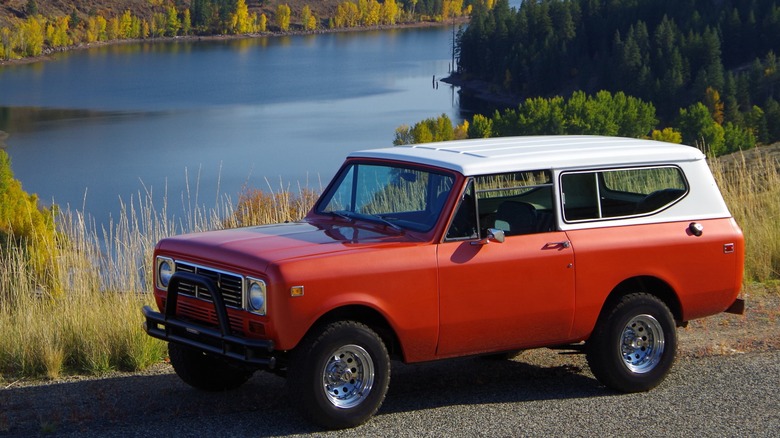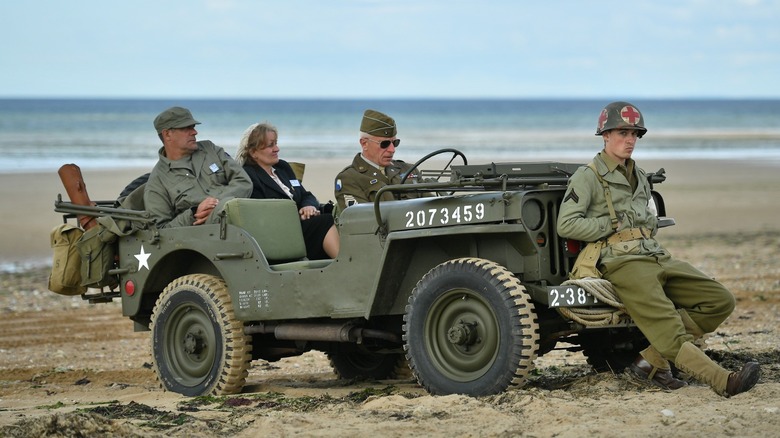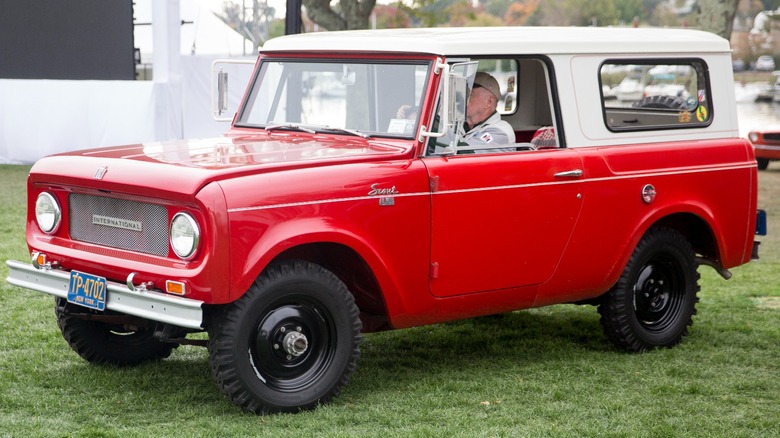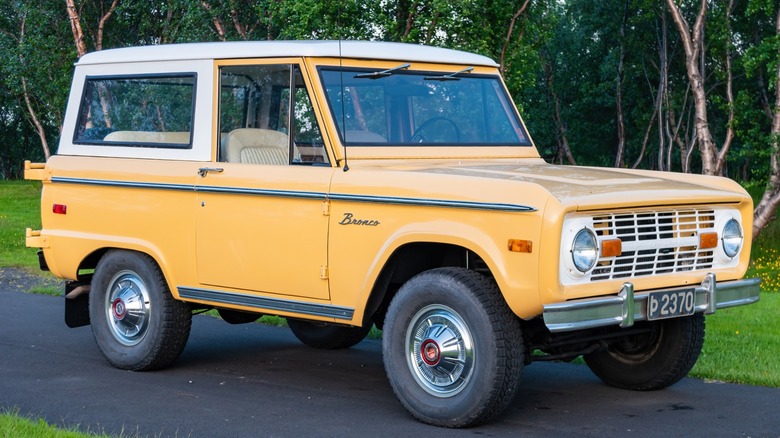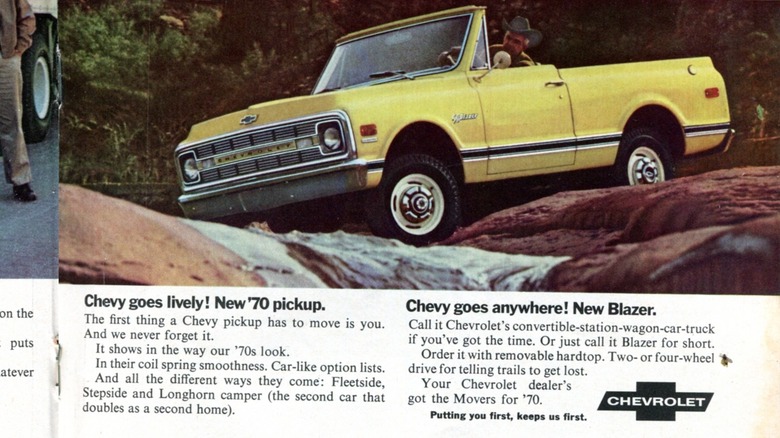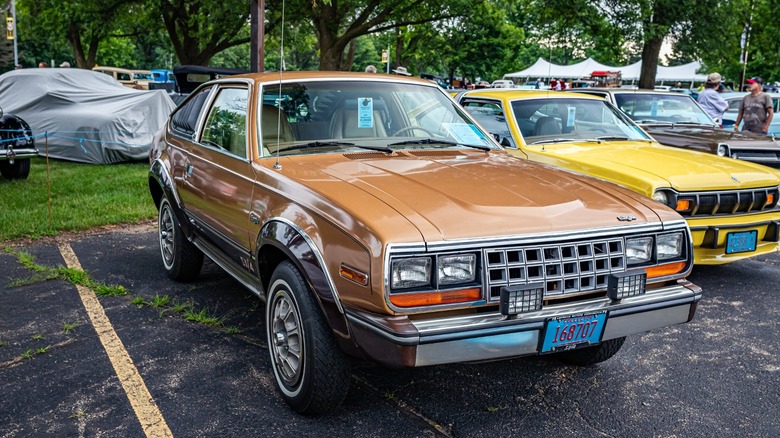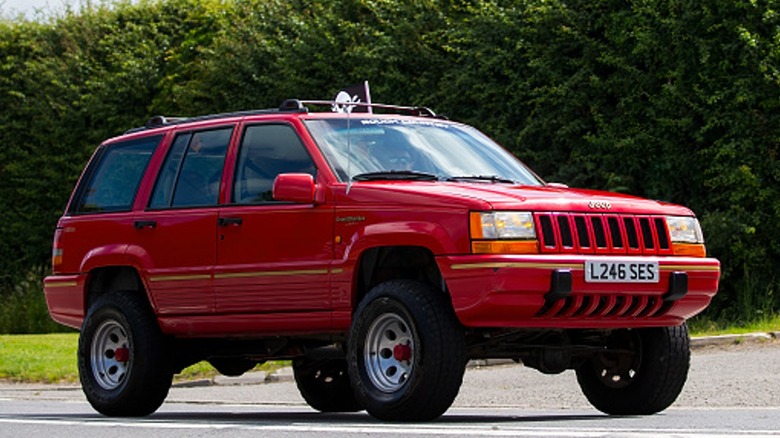6 Cars And Trucks That Helped Pave The Way For Modern SUVs
Parking lots today are filled with large trucks and SUVs that deliver the pinnacle in safety, space, and comfort. In fact, Good Car Bad Car reports that 46% of new vehicle sales in the U.S. are SUVs and crossovers.
But this wasn't always true. Families used to drive in sedans and station wagons. Pickup trucks and other similarly-sized vehicles were for commercial use. But as automotive tech developed, and the market evolved, demand for larger vehicles grew until SUVs and crossovers overtook sedan sales in 2017, as reported by The Autopian.
Of course, the SUV craze did not appear out of nowhere. Instead, it slowly came from developments made by automakers that caught the public eye. So, how did we get to large, cushy SUVs from the barebones cargo transport in the '40s and '50s? Let's check out these iconic vehicles that helped bring the about SUV we know today.
1944 Willys MB
When you think of a 4x4 SUV designed for off-road use, you'd probably envision the Jeep Wrangler. However, our grandparents and great-grandparents probably witnessed the first SUV as the predecessor of this iconic vehicle: the Willys MB.
Just before the outbreak of World War II, the U.S. Army recognized that it needed a light truck for reconnaissance and transportation. So, it organized a competition, with Willys-Overland winning the final contract. Eventually, over 600,000 were built and sent to all fronts in the war. This massive effort meant the Willys MB was the first 4x4 vehicle to be mass-produced.
Thousands if not millions of GIs ultimately rode these vehicles throughout the war. Furthermore, civilians in the Americas, Europe, and Asia have seen the Willys MB in action. When the war ended, many of these Jeeps were sold off or reused in the countries where American forces left them behind.
1960 International Harvester Scout
While the Willys MB, which eventually became the Jeep CJ and then the Jeep Wrangler, was the first popular SUV (or, more appropriately, the quarter-ton light truck, as the term SUV hadn't been invented yet), it was still focused primarily on commercial use. That meant it had few to no creature comforts, making it difficult to use as a daily driver for most families.
But, in 1960, the International Harvester company — known for its trucks and farm equipment — launched the Scout, its competitor for the Jeep. The Scout was more than just an off-road 4x4 vehicle. Instead, it offered a modern design and more engine options than its competitors. This made it a more fun option for those who want more performance and practicality from their vehicle.
However, despite the success of the Scout, the International Harvester company had to stop production as it faced financial challenges. This means there isn't a successor to the Scout today.
[Featured image by Mr.choppers via Wikimedia Commons | Cropped and scaled | CC BY-SA 3.0]
1966 Ford Bronco
The automotive media and many of its fans were abuzz when Ford relaunched the Bronco nameplate after almost 25 years since it last rolled off the factory floor. Today, Ford Bronco comes in three flavors: the two-door Bronco, the four-door Bronco, and the crossover-based Bronco Sport.
This follows the spirit of the first Ford Bronco, brought to market in 1966 to compete against the Scout and the Jeep CJ. According to the Ford Motor Company, "...the Bronco became a palette that each owner could, and did, modify for their lifestyle. In its basic configuration, the Bronco was as comfortable on the highway as the trailhead, but with some modification, could win at Baja."
Like the SUVs we see today, the first Ford Bronco prioritized comfort alongside utility in off-road conditions. Don Frey, the Ford Product Manager behind the Mustang and also worked on the Bronco, described it as "neither a conventional car nor a truck [...] It can serve as a family sedan, a sports roadster, a snow plow, or a farm or civil defense vehicle. It has been designed to go nearly anywhere and do nearly anything."
This kind of flexibility made the Ford Bronco a well-loved vehicle, causing more people to consider the SUV as a daily driver. It was also the first SUV from Ford, which eventually led to its other successful models today like the 2025 Ford Explorer and Mustang Mach-E.
1969 Chevrolet K5 Blazer
The success of the Scout and the Bronco caught the attention of the executives at General Motors/Chevrolet, who wanted a slice of the growing SUV pie. But instead of building a car from scratch, the company opted for the K5 Blazer from the C/K truck platform, allowing it to bring the vehicle to market much more quickly.
Although Chevrolet has been making the Suburban for decades at this point, that model was geared more towards businesses, meaning it wasn't the SUV for families and young professionals. The K5 Blazer was larger than its competition, owing to its full-size pickup truck roots, making it suitable for those with kids.
It also had a host of creature comforts like air-conditioning, power steering, a smoother suspension, and many engine options. With the K5 Blazer, the SUV transformed from an off-road adventure vehicle into a comfortable family hauler to take the kids fishing or camping.
[Featured image by SenseiAlan via Flickr | Cropped and scaled | CC BY 2.0]
1980 AMC Eagle
Before the AMC Eagle, SUVs were often based on the body-on-frame chassis design used in trucks. Although this gave the SUV its trademark taller height and better off-road ability, it also made them less comfortable and consume more fuel than sedans.
In 1979, AMC — Jeep's parent company — struggled due to increased competition and regulations. In a last-ditch attempt to make profitability, it made the Eagle, an SUV based on the AMC Concord sedan and equipped with Jeep features, like a four-wheel drive system.
This setup made the AMC Eagle the first-ever crossover: a car-based SUV with a unibody construction. By combining comfort with its light off-road capabilities, the AMC Eagle became an unexpected hit. AMC produced the car until 1987 when Chrysler bought the company and discontinued the model soon after. Although the AMC marque is no longer around, the legacy of the AMC Eagle can be seen in the numerous crossover SUVs today, like the 2023 Toyota Corolla Cross Hybrid and the 2024 Hyundai Santa Fe.
1984 Jeep Cherokee
Although the 1984 Jeep Cherokee didn't make our list of the best Jeeps of all time, it still made a mark as the first true modern SUV of our time. According to Keith Bradsher in the book 'High and Mighty,' "..it was the 1984 Cherokee that started the SUV boom because it spawned some very important imitators."
The 1984 Jeep Cherokee was a product of the oil crisis in the '70s, substituting the previous generation's body-on-frame chassis with unibody construction. This made the Cherokee much lighter than its competitors, improving its fuel economy. It also spawned the compact crossover segment, which gave us iconic vehicles like the Toyota RAV4 and the Honda CR-V.
Today, we have many options in the SUV space. From giant behemoths like the 2025 Chevrolet Suburban to smaller, pint-sized models like the 2025 MINI John Cooper Works Countryman, there's an SUV for everyone. But if not for these vehicles that led the way, we wouldn't have the comfort, safety, and performance we enjoy in SUVs today.
